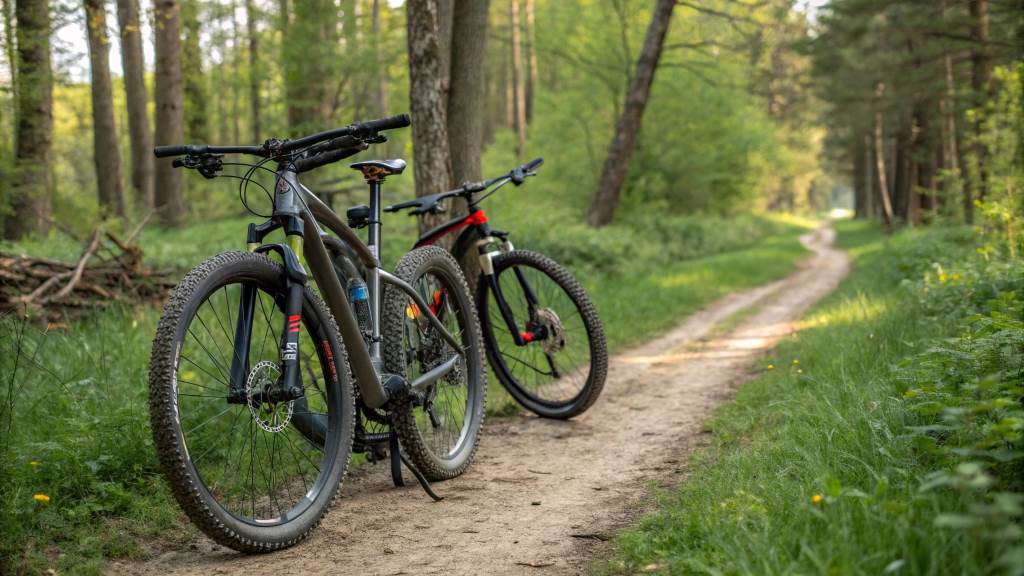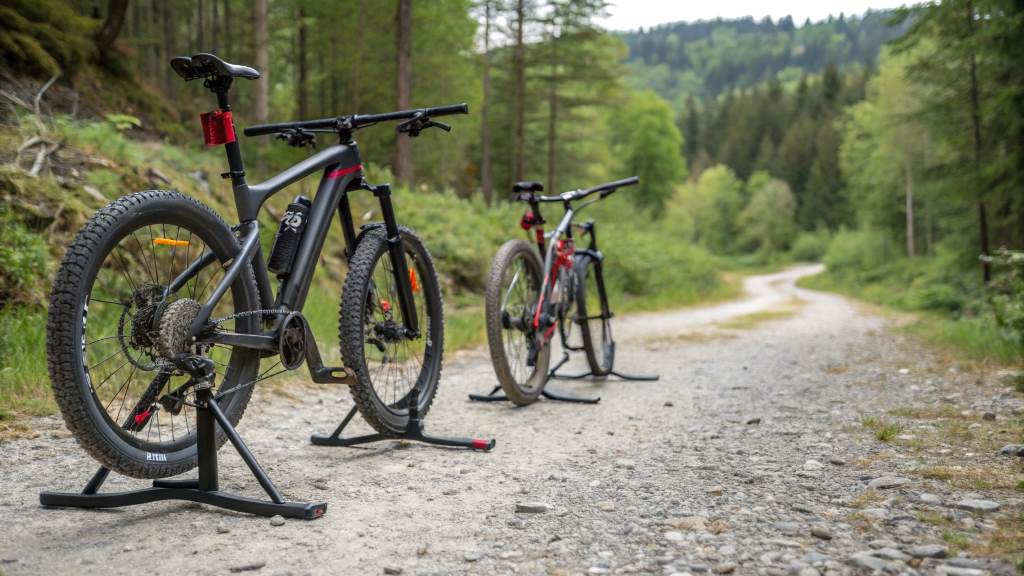Mountain biking, a sport celebrated for its adrenaline-pumping descents, technical climbs, and rugged trails, often carries an aura of minimalist functionality. In this pursuit of lightweight performance and uncompromised agility, the humble mountain bike kickstands seem conspicuously absent. However, the question lingers: can you put a kickstand on a mountain bike? And more importantly, should you?
This article delves into the intricacies of mountain bike kickstands, dissecting the practicalities, addressing the controversies, and providing a comprehensive guide for riders considering this addition. We’ll explore the different types of kickstands, the installation process, the potential benefits, and the reasons why many purists eschew them.
Understanding the Mountain Biking Ethos: Why Mountain Bike Kickstands are Often Overlooked
Mountain biking, at its core, is about conquering challenging terrain with efficiency and control. Weight is a critical factor, as every extra ounce can impact climbing speed and maneuverability. Traditional mountain bike design prioritizes stripping away unnecessary components to maximize performance. This philosophy extends to kickstands, which are often perceived as adding unnecessary weight and potentially hindering performance on technical trails.

Furthermore, the very nature of mountain biking often involves riding in environments where a kickstand would be impractical or even detrimental—much like how BMX rules highlight constant movement and agility. Rocky terrain, steep inclines, and narrow trails offer limited opportunities for a bike to stand upright on its own. The focus is on riding, not parking.
The Practicality of a Kickstand: When It Makes Sense
While the purist argument against kickstands holds merit for hardcore trail riders, there are scenarios where a kickstand can be remarkably practical. Consider these situations:
- Casual Trail Riding and Commuting: For riders who use their mountain bikes for a mix of casual trail riding, commuting, and general transportation, a kickstand can be a convenient addition. It eliminates the need to lean the bike against walls, trees, or other surfaces, preventing scratches and potential damage.
- Bike Packing and Touring: When embarking on multi-day bike packing trips or touring adventures, a kickstand can be invaluable for parking the bike during breaks, overnight stops, or when loading and unloading gear.
- E-Mountain Bikes: Electric mountain bikes, with their increased weight, can be cumbersome to lean against surfaces. A kickstand provides a stable and convenient parking solution.
- Riders with Physical Limitations: For riders with physical limitations or balance issues, a kickstand can provide added stability and convenience.
- General Convenience: Simply put, a kickstand makes it easier to park your bike when you need to take a break, grab a photo, or attend to something.
Types of Kickstands Suitable for Mountain Bikes
If you’ve decided a kickstand is right for you, it’s essential to choose the right type. Here are the most common options:
- Chainstay-Mounted Kickstands: These are the most common type and attach to the chainstay near the rear wheel. They are relatively easy to install and provide a stable support. However, they require sufficient clearance between the chainstay and the rear tire.
- Center-Mounted Kickstands: These kickstands mount to the bottom bracket area of the frame, providing a more balanced support. They are often adjustable in length and can be suitable for bikes with varying frame geometries.
- Rear Axle-Mounted Kickstands: These kickstands attach to the rear axle quick release or thru-axle, offering a clean and minimalist look. They are typically lightweight and easy to install.
- Internal Kickstands: Some higher end bikes have internal kickstand mounting points. These are the cleanest looking, but require a bike frame that is designed for them.
Installation Process: A Step-by-Step Guide
Installing a kickstand is generally a straightforward process that can be done with basic tools. Here’s a general guide:
- Choose the Right Kickstand: Select a kickstand that is compatible with your bike’s frame and wheel size.
- Clean the Mounting Area: Ensure the chainstay or bottom bracket area is clean and free of dirt or debris.
- Position the Kickstand: Position the kickstand against the mounting area and align it properly.
- Secure the Bolts: Use the provided bolts to secure the kickstand to the frame. Tighten the bolts evenly and securely, but avoid over-tightening.
- Adjust the Length: Adjust the length of the kickstand so that the bike stands upright with a slight lean.
- Test the Stability: Test the stability of the kickstand by gently rocking the bike. Make sure it stands securely and doesn’t wobble.
Addressing the Controversies: Weight, Clearance, and Trail Performance
The primary arguments against kickstands revolve around weight, clearance, and potential impact on trail performance.
- Weight: Kickstands add weight to the bike, which can be a concern for riders focused on maximizing performance. However, the weight penalty is typically minimal, especially for casual riders.
- Clearance: Some kickstands may interfere with tire clearance or suspension movement, particularly on full-suspension bikes. It’s crucial to choose a kickstand that is compatible with your bike’s frame geometry and suspension design.
- Trail Performance: In extreme cases, a poorly installed or incompatible kickstand could potentially snag on obstacles or interfere with riding technique. However, with proper installation and a suitable kickstand, this risk is minimal.
Debunking Myths: Separating Fact from Fiction
Many misconceptions surround mountain bike kickstands. Here are a few common myths debunked:
- Myth: Kickstands are only for “casual” riders.
- Fact: Kickstands can be practical for a variety of riders, including bike packers, commuters, and e-mountain bike users.
- Myth: Kickstands will damage your frame.
- Fact: Properly installed kickstands are unlikely to damage your frame.
- Myth: Kickstands are heavy and will significantly impact performance.
- Fact: The weight penalty of a kickstand is typically minimal and unlikely to have a significant impact on performance for most riders.
People Also Ask (FAQs)
Q: Will a kickstand fit on any mountain bike?
A: Not necessarily. Compatibility depends on the frame geometry and the type of kickstand. It’s essential to choose a kickstand that is compatible with your bike.
Q: Are kickstands heavy?
A: Kickstands add weight, but the penalty is usually minimal.
Q: Will a kickstand interfere with my suspension?
A: It’s possible, especially on full-suspension bikes. Choose a kickstand that provides adequate clearance.
Q: Can I install a kickstand myself?
A: Yes, installing a kickstand is generally a straightforward process that can be done with basic tools.
Q: Are there lightweight kickstands for mountain bikes?
A: Yes, there are lightweight options, particularly rear axle-mounted kickstands.
Q: Are center mount kickstands more stable?
A: Yes, center mount kickstands generally provide more balanced support.
Q: Can I install a kickstand on a carbon frame?
A: Yes, but be careful not to over tighten the bolts. Follow manufacturer instructions.
Q: What is the best type of kickstand for bike packing?
A: Chainstay or center mount kickstands are good for bike packing due to their stability.
Q: Do kickstands look bad on a mountain bike?
A: This is subjective. Some riders find them aesthetically unappealing, while others prioritize practicality.
Conclusion: Weighing the Pros and Cons
The decision of whether to put a kickstand on a mountain bike ultimately comes down to individual needs and preferences. While the purist argument against mountain bike kickstands holds merit for hardcore trail riders, there are numerous scenarios where a kickstand can be a practical and convenient addition.
For casual riders, commuters, bike packers, and e-mountain bike users, the benefits of a kickstand often outweigh the potential drawbacks. By choosing the right type of kickstand and installing it properly, riders can enjoy the convenience of a stable parking solution without compromising their riding experience.
Ultimately, the choice is yours. Consider your riding style, your needs, and your priorities. If convenience and practicality are paramount, a kickstand might be the perfect addition to your mountain bike.

Welcome to outdoorxsports.com! I’m Russell, your guide to the awesome world of mountain biking. This blog is all about building a community of riders who love to share their passion for the sport. Expect inspiring stories, local trail recommendations, fun challenges, and tips for making the most of your time on two wheels.

